Financial Report: Transurban Holdings Ltd and Accounting Regulations
VerifiedAdded on 2022/10/15
|9
|1925
|314
Report
AI Summary
This report, prepared for the CFO of Transurban Holdings Ltd (TCL), an ASX-listed toll road operator, analyzes the financial implications of TCL's exposure to industry risks. It identifies and summarizes the accounting policies governing toll road concessions, as dictated by regulations, referencing AASB Interpretation 12. The report explains the flexibility in asset valuation, particularly for concession assets, which constitute a significant portion of TCL's total assets, and outlines the potential impacts of toll road business deterioration on financial statements, including the income statement and balance sheet. Furthermore, it evaluates the economic consequences of factors such as increased oil prices and reduced private vehicle use, along with the application of accounting principles in TCL's financial reporting, including the economic entity approach and audit methodologies. The report references relevant accounting standards like AASB 7, AASB 9, and AASB 15, and considers potential risks and opportunities impacting TCL's financial results, offering a comprehensive overview of TCL's financial position within the toll road industry.
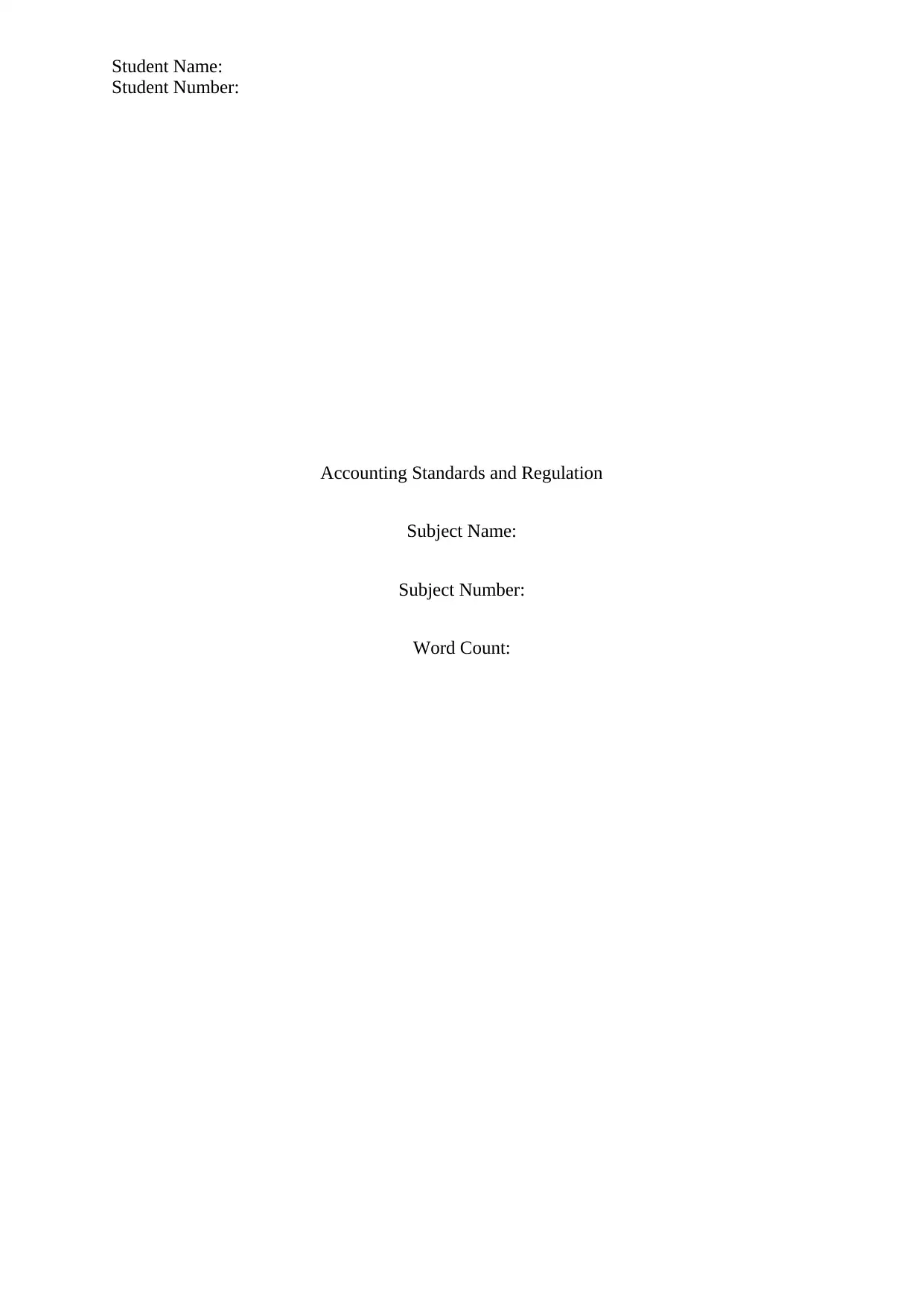
Student Name:
Student Number:
Accounting Standards and Regulation
Subject Name:
Subject Number:
Word Count:
Student Number:
Accounting Standards and Regulation
Subject Name:
Subject Number:
Word Count:
Paraphrase This Document
Need a fresh take? Get an instant paraphrase of this document with our AI Paraphraser
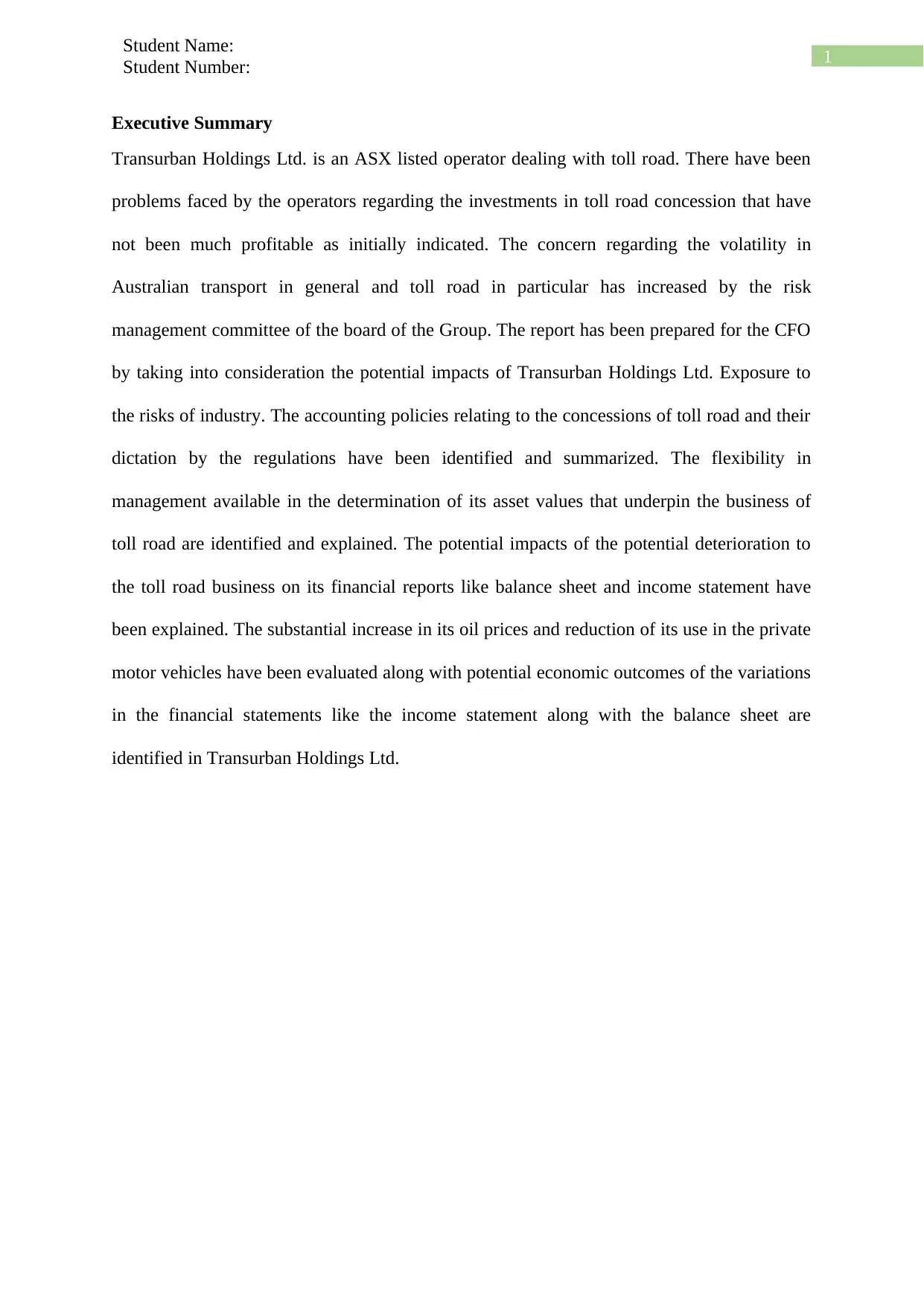
1
Student Name:
Student Number:
Executive Summary
Transurban Holdings Ltd. is an ASX listed operator dealing with toll road. There have been
problems faced by the operators regarding the investments in toll road concession that have
not been much profitable as initially indicated. The concern regarding the volatility in
Australian transport in general and toll road in particular has increased by the risk
management committee of the board of the Group. The report has been prepared for the CFO
by taking into consideration the potential impacts of Transurban Holdings Ltd. Exposure to
the risks of industry. The accounting policies relating to the concessions of toll road and their
dictation by the regulations have been identified and summarized. The flexibility in
management available in the determination of its asset values that underpin the business of
toll road are identified and explained. The potential impacts of the potential deterioration to
the toll road business on its financial reports like balance sheet and income statement have
been explained. The substantial increase in its oil prices and reduction of its use in the private
motor vehicles have been evaluated along with potential economic outcomes of the variations
in the financial statements like the income statement along with the balance sheet are
identified in Transurban Holdings Ltd.
Student Name:
Student Number:
Executive Summary
Transurban Holdings Ltd. is an ASX listed operator dealing with toll road. There have been
problems faced by the operators regarding the investments in toll road concession that have
not been much profitable as initially indicated. The concern regarding the volatility in
Australian transport in general and toll road in particular has increased by the risk
management committee of the board of the Group. The report has been prepared for the CFO
by taking into consideration the potential impacts of Transurban Holdings Ltd. Exposure to
the risks of industry. The accounting policies relating to the concessions of toll road and their
dictation by the regulations have been identified and summarized. The flexibility in
management available in the determination of its asset values that underpin the business of
toll road are identified and explained. The potential impacts of the potential deterioration to
the toll road business on its financial reports like balance sheet and income statement have
been explained. The substantial increase in its oil prices and reduction of its use in the private
motor vehicles have been evaluated along with potential economic outcomes of the variations
in the financial statements like the income statement along with the balance sheet are
identified in Transurban Holdings Ltd.
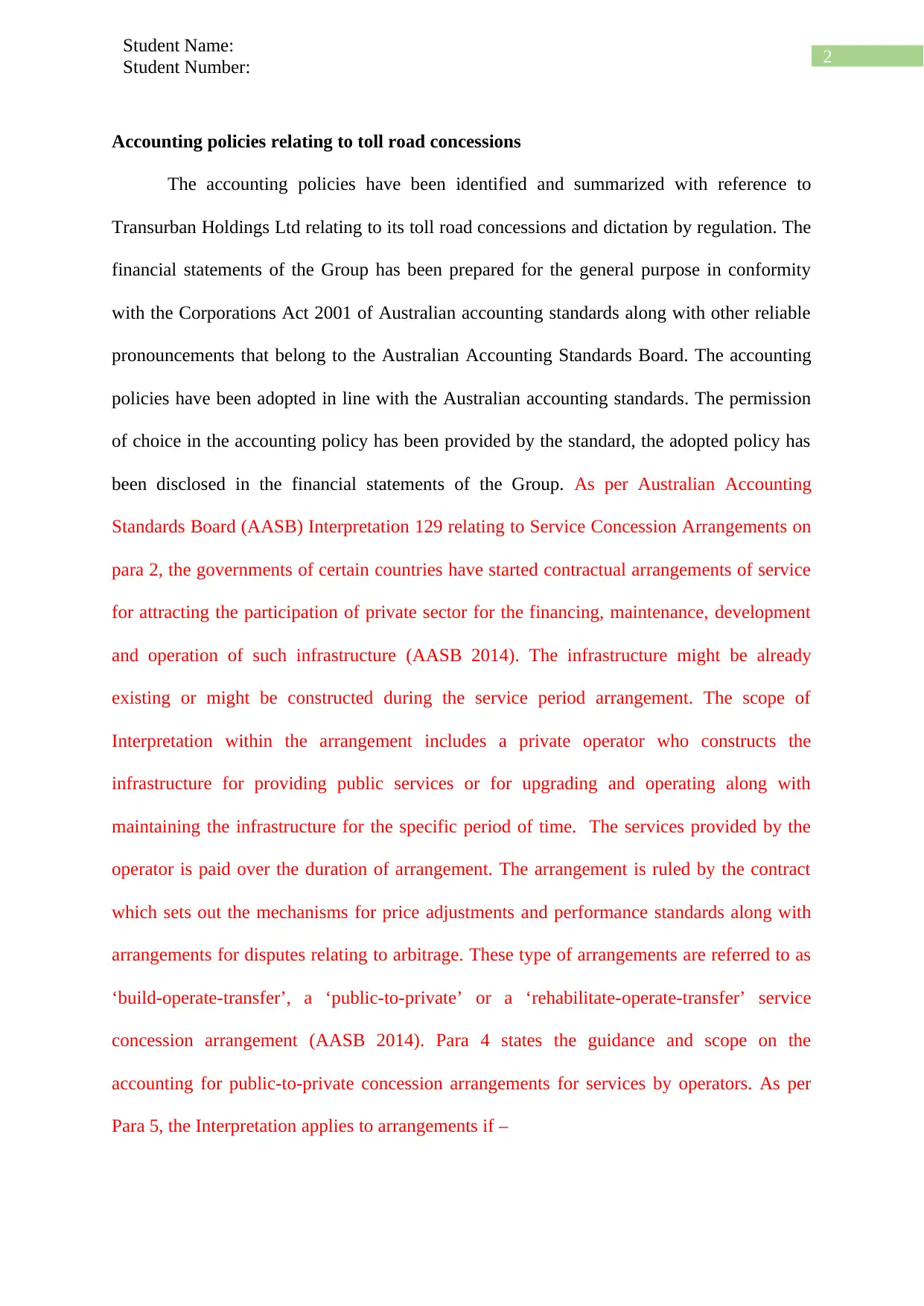
2
Student Name:
Student Number:
Accounting policies relating to toll road concessions
The accounting policies have been identified and summarized with reference to
Transurban Holdings Ltd relating to its toll road concessions and dictation by regulation. The
financial statements of the Group has been prepared for the general purpose in conformity
with the Corporations Act 2001 of Australian accounting standards along with other reliable
pronouncements that belong to the Australian Accounting Standards Board. The accounting
policies have been adopted in line with the Australian accounting standards. The permission
of choice in the accounting policy has been provided by the standard, the adopted policy has
been disclosed in the financial statements of the Group. As per Australian Accounting
Standards Board (AASB) Interpretation 129 relating to Service Concession Arrangements on
para 2, the governments of certain countries have started contractual arrangements of service
for attracting the participation of private sector for the financing, maintenance, development
and operation of such infrastructure (AASB 2014). The infrastructure might be already
existing or might be constructed during the service period arrangement. The scope of
Interpretation within the arrangement includes a private operator who constructs the
infrastructure for providing public services or for upgrading and operating along with
maintaining the infrastructure for the specific period of time. The services provided by the
operator is paid over the duration of arrangement. The arrangement is ruled by the contract
which sets out the mechanisms for price adjustments and performance standards along with
arrangements for disputes relating to arbitrage. These type of arrangements are referred to as
‘build-operate-transfer’, a ‘public-to-private’ or a ‘rehabilitate-operate-transfer’ service
concession arrangement (AASB 2014). Para 4 states the guidance and scope on the
accounting for public-to-private concession arrangements for services by operators. As per
Para 5, the Interpretation applies to arrangements if –
Student Name:
Student Number:
Accounting policies relating to toll road concessions
The accounting policies have been identified and summarized with reference to
Transurban Holdings Ltd relating to its toll road concessions and dictation by regulation. The
financial statements of the Group has been prepared for the general purpose in conformity
with the Corporations Act 2001 of Australian accounting standards along with other reliable
pronouncements that belong to the Australian Accounting Standards Board. The accounting
policies have been adopted in line with the Australian accounting standards. The permission
of choice in the accounting policy has been provided by the standard, the adopted policy has
been disclosed in the financial statements of the Group. As per Australian Accounting
Standards Board (AASB) Interpretation 129 relating to Service Concession Arrangements on
para 2, the governments of certain countries have started contractual arrangements of service
for attracting the participation of private sector for the financing, maintenance, development
and operation of such infrastructure (AASB 2014). The infrastructure might be already
existing or might be constructed during the service period arrangement. The scope of
Interpretation within the arrangement includes a private operator who constructs the
infrastructure for providing public services or for upgrading and operating along with
maintaining the infrastructure for the specific period of time. The services provided by the
operator is paid over the duration of arrangement. The arrangement is ruled by the contract
which sets out the mechanisms for price adjustments and performance standards along with
arrangements for disputes relating to arbitrage. These type of arrangements are referred to as
‘build-operate-transfer’, a ‘public-to-private’ or a ‘rehabilitate-operate-transfer’ service
concession arrangement (AASB 2014). Para 4 states the guidance and scope on the
accounting for public-to-private concession arrangements for services by operators. As per
Para 5, the Interpretation applies to arrangements if –
⊘ This is a preview!⊘
Do you want full access?
Subscribe today to unlock all pages.

Trusted by 1+ million students worldwide
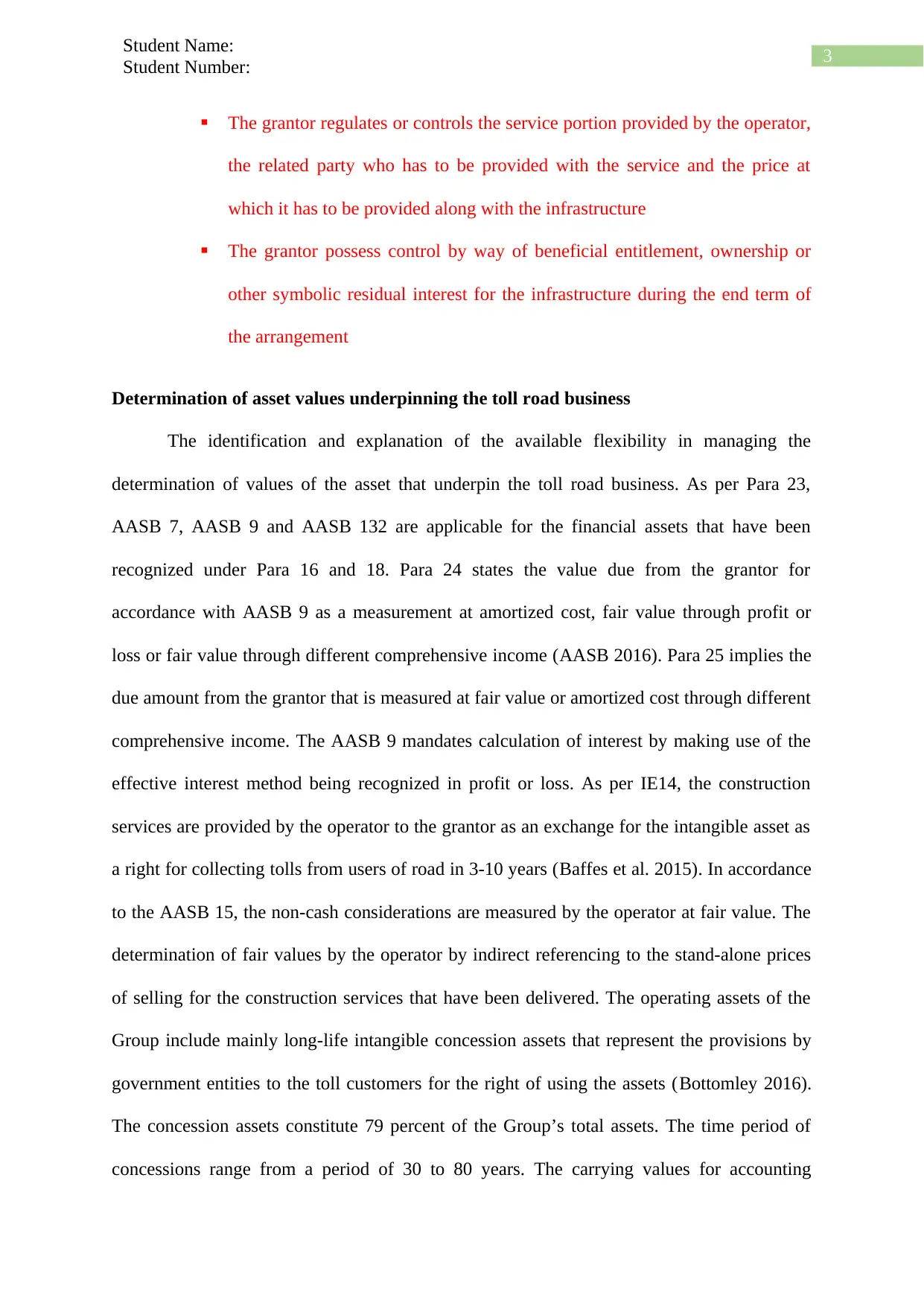
3
Student Name:
Student Number:
The grantor regulates or controls the service portion provided by the operator,
the related party who has to be provided with the service and the price at
which it has to be provided along with the infrastructure
The grantor possess control by way of beneficial entitlement, ownership or
other symbolic residual interest for the infrastructure during the end term of
the arrangement
Determination of asset values underpinning the toll road business
The identification and explanation of the available flexibility in managing the
determination of values of the asset that underpin the toll road business. As per Para 23,
AASB 7, AASB 9 and AASB 132 are applicable for the financial assets that have been
recognized under Para 16 and 18. Para 24 states the value due from the grantor for
accordance with AASB 9 as a measurement at amortized cost, fair value through profit or
loss or fair value through different comprehensive income (AASB 2016). Para 25 implies the
due amount from the grantor that is measured at fair value or amortized cost through different
comprehensive income. The AASB 9 mandates calculation of interest by making use of the
effective interest method being recognized in profit or loss. As per IE14, the construction
services are provided by the operator to the grantor as an exchange for the intangible asset as
a right for collecting tolls from users of road in 3-10 years (Baffes et al. 2015). In accordance
to the AASB 15, the non-cash considerations are measured by the operator at fair value. The
determination of fair values by the operator by indirect referencing to the stand-alone prices
of selling for the construction services that have been delivered. The operating assets of the
Group include mainly long-life intangible concession assets that represent the provisions by
government entities to the toll customers for the right of using the assets (Bottomley 2016).
The concession assets constitute 79 percent of the Group’s total assets. The time period of
concessions range from a period of 30 to 80 years. The carrying values for accounting
Student Name:
Student Number:
The grantor regulates or controls the service portion provided by the operator,
the related party who has to be provided with the service and the price at
which it has to be provided along with the infrastructure
The grantor possess control by way of beneficial entitlement, ownership or
other symbolic residual interest for the infrastructure during the end term of
the arrangement
Determination of asset values underpinning the toll road business
The identification and explanation of the available flexibility in managing the
determination of values of the asset that underpin the toll road business. As per Para 23,
AASB 7, AASB 9 and AASB 132 are applicable for the financial assets that have been
recognized under Para 16 and 18. Para 24 states the value due from the grantor for
accordance with AASB 9 as a measurement at amortized cost, fair value through profit or
loss or fair value through different comprehensive income (AASB 2016). Para 25 implies the
due amount from the grantor that is measured at fair value or amortized cost through different
comprehensive income. The AASB 9 mandates calculation of interest by making use of the
effective interest method being recognized in profit or loss. As per IE14, the construction
services are provided by the operator to the grantor as an exchange for the intangible asset as
a right for collecting tolls from users of road in 3-10 years (Baffes et al. 2015). In accordance
to the AASB 15, the non-cash considerations are measured by the operator at fair value. The
determination of fair values by the operator by indirect referencing to the stand-alone prices
of selling for the construction services that have been delivered. The operating assets of the
Group include mainly long-life intangible concession assets that represent the provisions by
government entities to the toll customers for the right of using the assets (Bottomley 2016).
The concession assets constitute 79 percent of the Group’s total assets. The time period of
concessions range from a period of 30 to 80 years. The carrying values for accounting
Paraphrase This Document
Need a fresh take? Get an instant paraphrase of this document with our AI Paraphraser
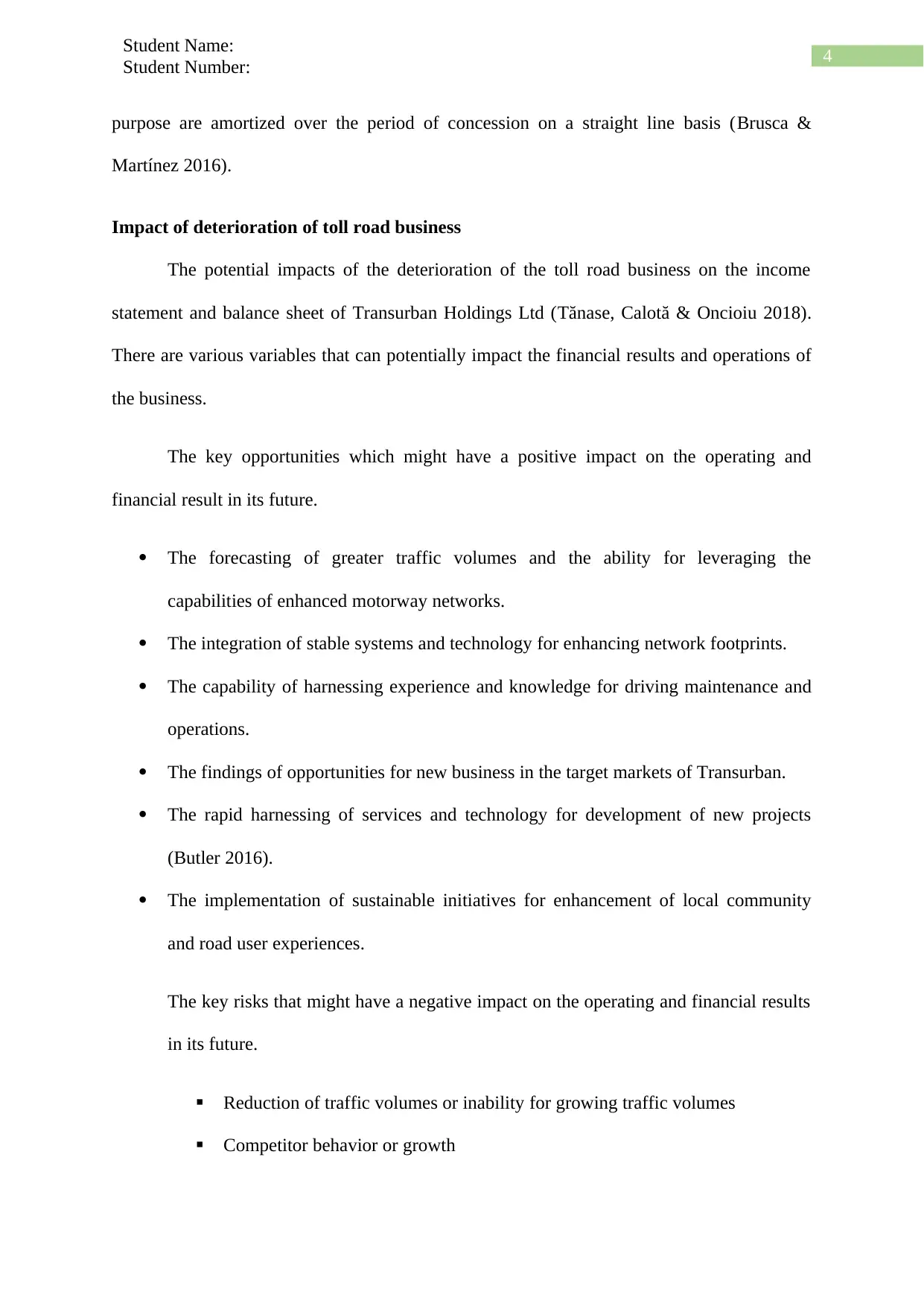
4
Student Name:
Student Number:
purpose are amortized over the period of concession on a straight line basis (Brusca &
Martínez 2016).
Impact of deterioration of toll road business
The potential impacts of the deterioration of the toll road business on the income
statement and balance sheet of Transurban Holdings Ltd (Tănase, Calotă & Oncioiu 2018).
There are various variables that can potentially impact the financial results and operations of
the business.
The key opportunities which might have a positive impact on the operating and
financial result in its future.
The forecasting of greater traffic volumes and the ability for leveraging the
capabilities of enhanced motorway networks.
The integration of stable systems and technology for enhancing network footprints.
The capability of harnessing experience and knowledge for driving maintenance and
operations.
The findings of opportunities for new business in the target markets of Transurban.
The rapid harnessing of services and technology for development of new projects
(Butler 2016).
The implementation of sustainable initiatives for enhancement of local community
and road user experiences.
The key risks that might have a negative impact on the operating and financial results
in its future.
Reduction of traffic volumes or inability for growing traffic volumes
Competitor behavior or growth
Student Name:
Student Number:
purpose are amortized over the period of concession on a straight line basis (Brusca &
Martínez 2016).
Impact of deterioration of toll road business
The potential impacts of the deterioration of the toll road business on the income
statement and balance sheet of Transurban Holdings Ltd (Tănase, Calotă & Oncioiu 2018).
There are various variables that can potentially impact the financial results and operations of
the business.
The key opportunities which might have a positive impact on the operating and
financial result in its future.
The forecasting of greater traffic volumes and the ability for leveraging the
capabilities of enhanced motorway networks.
The integration of stable systems and technology for enhancing network footprints.
The capability of harnessing experience and knowledge for driving maintenance and
operations.
The findings of opportunities for new business in the target markets of Transurban.
The rapid harnessing of services and technology for development of new projects
(Butler 2016).
The implementation of sustainable initiatives for enhancement of local community
and road user experiences.
The key risks that might have a negative impact on the operating and financial results
in its future.
Reduction of traffic volumes or inability for growing traffic volumes
Competitor behavior or growth
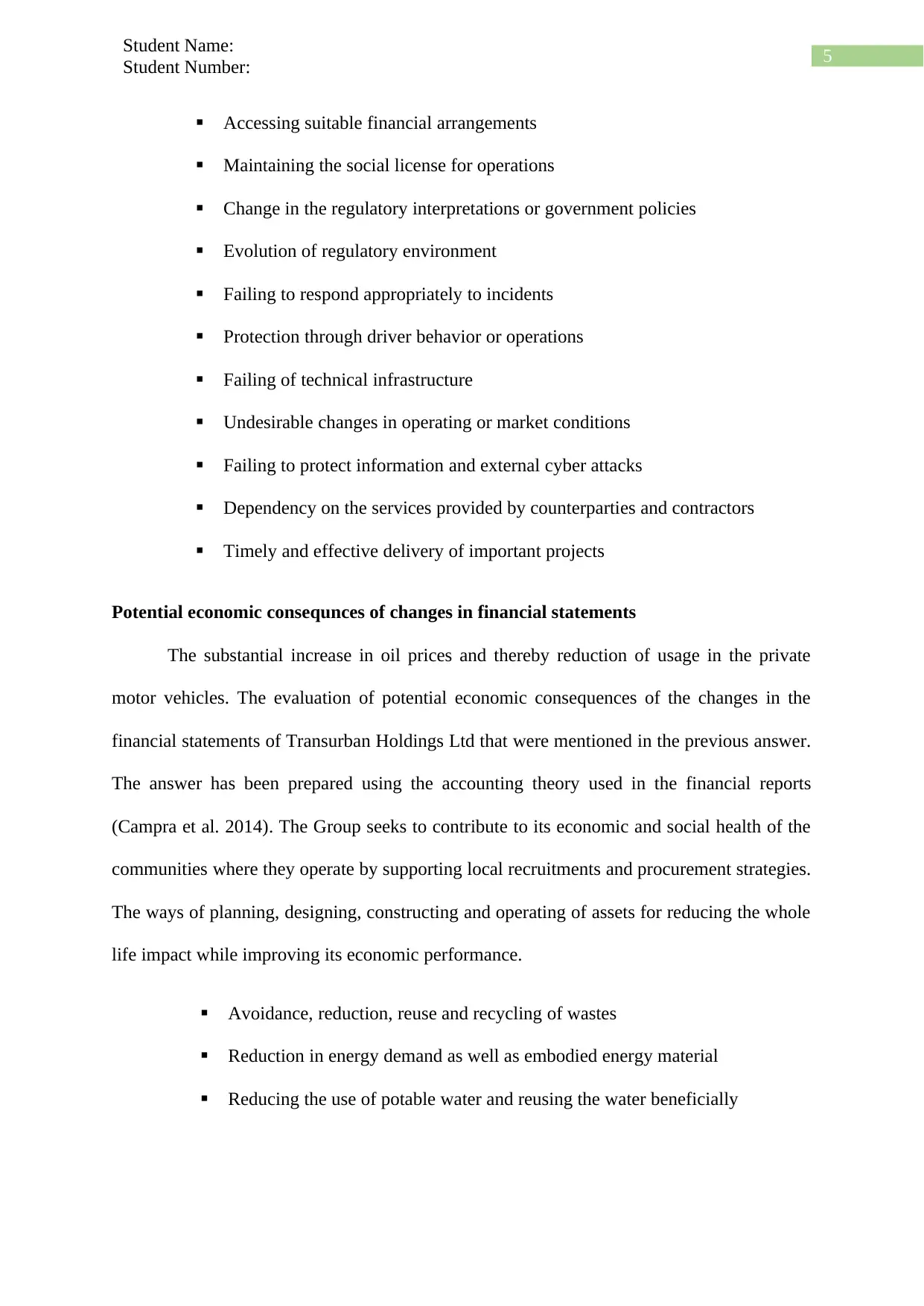
5
Student Name:
Student Number:
Accessing suitable financial arrangements
Maintaining the social license for operations
Change in the regulatory interpretations or government policies
Evolution of regulatory environment
Failing to respond appropriately to incidents
Protection through driver behavior or operations
Failing of technical infrastructure
Undesirable changes in operating or market conditions
Failing to protect information and external cyber attacks
Dependency on the services provided by counterparties and contractors
Timely and effective delivery of important projects
Potential economic consequnces of changes in financial statements
The substantial increase in oil prices and thereby reduction of usage in the private
motor vehicles. The evaluation of potential economic consequences of the changes in the
financial statements of Transurban Holdings Ltd that were mentioned in the previous answer.
The answer has been prepared using the accounting theory used in the financial reports
(Campra et al. 2014). The Group seeks to contribute to its economic and social health of the
communities where they operate by supporting local recruitments and procurement strategies.
The ways of planning, designing, constructing and operating of assets for reducing the whole
life impact while improving its economic performance.
Avoidance, reduction, reuse and recycling of wastes
Reduction in energy demand as well as embodied energy material
Reducing the use of potable water and reusing the water beneficially
Student Name:
Student Number:
Accessing suitable financial arrangements
Maintaining the social license for operations
Change in the regulatory interpretations or government policies
Evolution of regulatory environment
Failing to respond appropriately to incidents
Protection through driver behavior or operations
Failing of technical infrastructure
Undesirable changes in operating or market conditions
Failing to protect information and external cyber attacks
Dependency on the services provided by counterparties and contractors
Timely and effective delivery of important projects
Potential economic consequnces of changes in financial statements
The substantial increase in oil prices and thereby reduction of usage in the private
motor vehicles. The evaluation of potential economic consequences of the changes in the
financial statements of Transurban Holdings Ltd that were mentioned in the previous answer.
The answer has been prepared using the accounting theory used in the financial reports
(Campra et al. 2014). The Group seeks to contribute to its economic and social health of the
communities where they operate by supporting local recruitments and procurement strategies.
The ways of planning, designing, constructing and operating of assets for reducing the whole
life impact while improving its economic performance.
Avoidance, reduction, reuse and recycling of wastes
Reduction in energy demand as well as embodied energy material
Reducing the use of potable water and reusing the water beneficially
⊘ This is a preview!⊘
Do you want full access?
Subscribe today to unlock all pages.

Trusted by 1+ million students worldwide
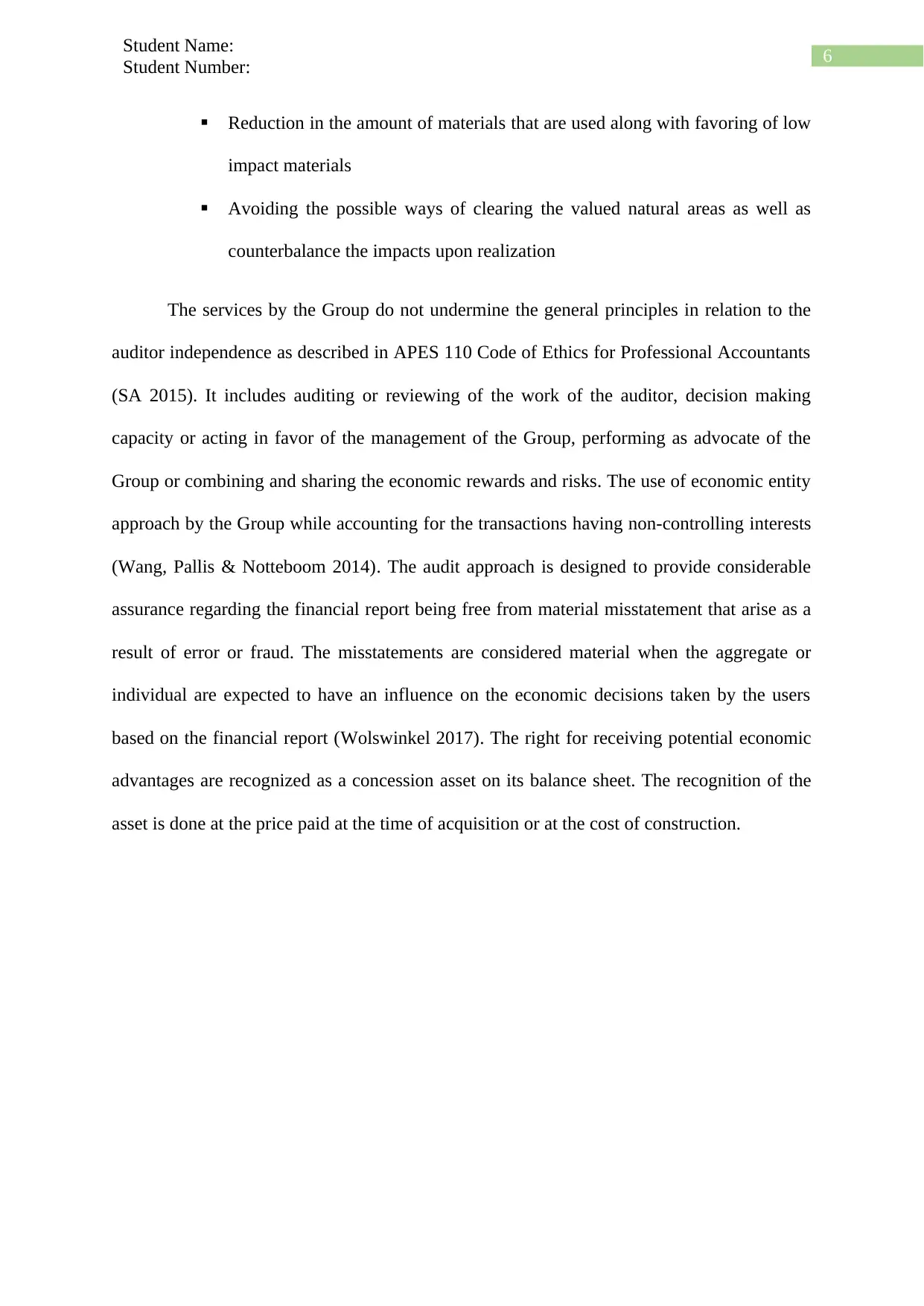
6
Student Name:
Student Number:
Reduction in the amount of materials that are used along with favoring of low
impact materials
Avoiding the possible ways of clearing the valued natural areas as well as
counterbalance the impacts upon realization
The services by the Group do not undermine the general principles in relation to the
auditor independence as described in APES 110 Code of Ethics for Professional Accountants
(SA 2015). It includes auditing or reviewing of the work of the auditor, decision making
capacity or acting in favor of the management of the Group, performing as advocate of the
Group or combining and sharing the economic rewards and risks. The use of economic entity
approach by the Group while accounting for the transactions having non-controlling interests
(Wang, Pallis & Notteboom 2014). The audit approach is designed to provide considerable
assurance regarding the financial report being free from material misstatement that arise as a
result of error or fraud. The misstatements are considered material when the aggregate or
individual are expected to have an influence on the economic decisions taken by the users
based on the financial report (Wolswinkel 2017). The right for receiving potential economic
advantages are recognized as a concession asset on its balance sheet. The recognition of the
asset is done at the price paid at the time of acquisition or at the cost of construction.
Student Name:
Student Number:
Reduction in the amount of materials that are used along with favoring of low
impact materials
Avoiding the possible ways of clearing the valued natural areas as well as
counterbalance the impacts upon realization
The services by the Group do not undermine the general principles in relation to the
auditor independence as described in APES 110 Code of Ethics for Professional Accountants
(SA 2015). It includes auditing or reviewing of the work of the auditor, decision making
capacity or acting in favor of the management of the Group, performing as advocate of the
Group or combining and sharing the economic rewards and risks. The use of economic entity
approach by the Group while accounting for the transactions having non-controlling interests
(Wang, Pallis & Notteboom 2014). The audit approach is designed to provide considerable
assurance regarding the financial report being free from material misstatement that arise as a
result of error or fraud. The misstatements are considered material when the aggregate or
individual are expected to have an influence on the economic decisions taken by the users
based on the financial report (Wolswinkel 2017). The right for receiving potential economic
advantages are recognized as a concession asset on its balance sheet. The recognition of the
asset is done at the price paid at the time of acquisition or at the cost of construction.
Paraphrase This Document
Need a fresh take? Get an instant paraphrase of this document with our AI Paraphraser
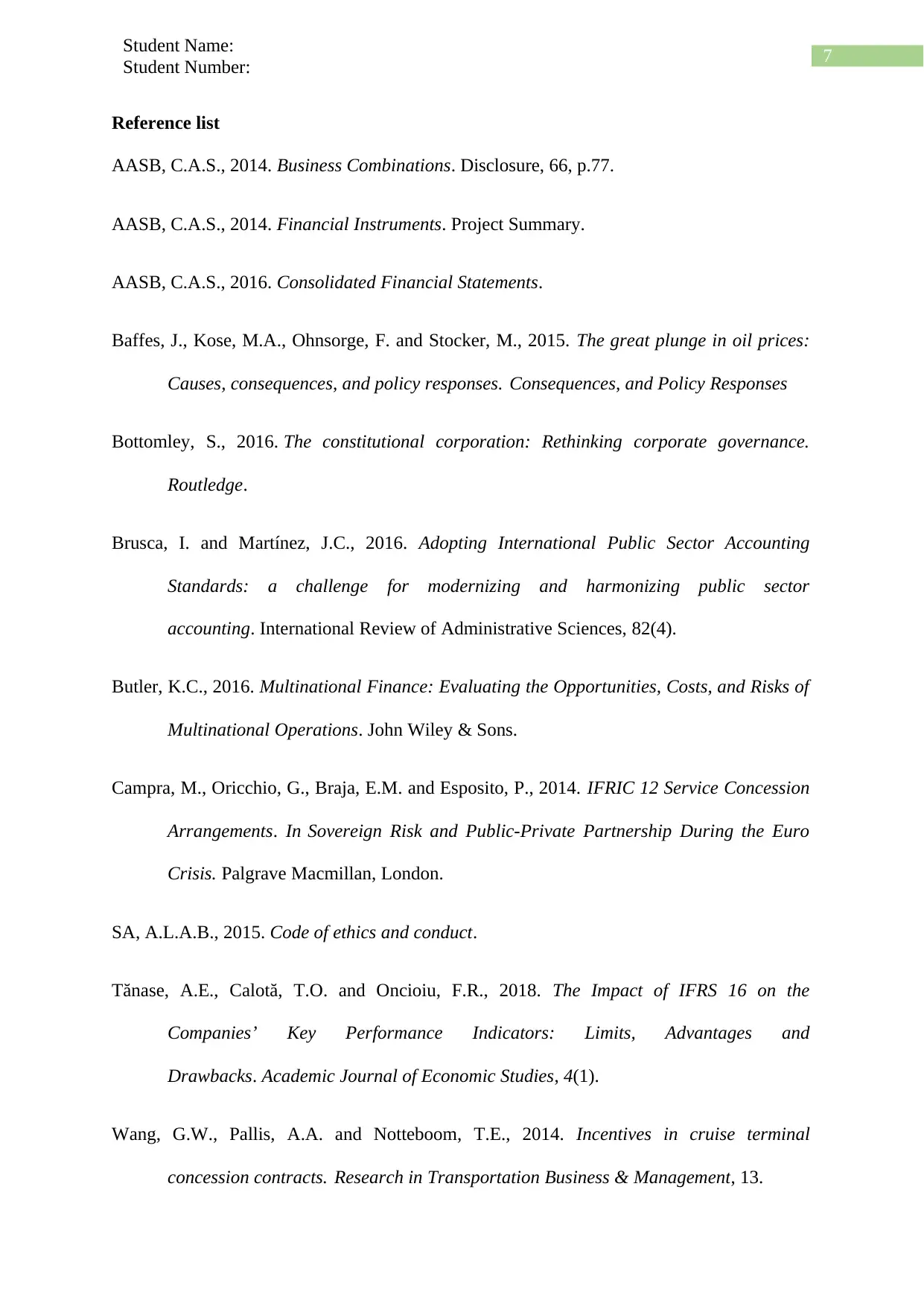
7
Student Name:
Student Number:
Reference list
AASB, C.A.S., 2014. Business Combinations. Disclosure, 66, p.77.
AASB, C.A.S., 2014. Financial Instruments. Project Summary.
AASB, C.A.S., 2016. Consolidated Financial Statements.
Baffes, J., Kose, M.A., Ohnsorge, F. and Stocker, M., 2015. The great plunge in oil prices:
Causes, consequences, and policy responses. Consequences, and Policy Responses
Bottomley, S., 2016. The constitutional corporation: Rethinking corporate governance.
Routledge.
Brusca, I. and Martínez, J.C., 2016. Adopting International Public Sector Accounting
Standards: a challenge for modernizing and harmonizing public sector
accounting. International Review of Administrative Sciences, 82(4).
Butler, K.C., 2016. Multinational Finance: Evaluating the Opportunities, Costs, and Risks of
Multinational Operations. John Wiley & Sons.
Campra, M., Oricchio, G., Braja, E.M. and Esposito, P., 2014. IFRIC 12 Service Concession
Arrangements. In Sovereign Risk and Public-Private Partnership During the Euro
Crisis. Palgrave Macmillan, London.
SA, A.L.A.B., 2015. Code of ethics and conduct.
Tănase, A.E., Calotă, T.O. and Oncioiu, F.R., 2018. The Impact of IFRS 16 on the
Companies’ Key Performance Indicators: Limits, Advantages and
Drawbacks. Academic Journal of Economic Studies, 4(1).
Wang, G.W., Pallis, A.A. and Notteboom, T.E., 2014. Incentives in cruise terminal
concession contracts. Research in Transportation Business & Management, 13.
Student Name:
Student Number:
Reference list
AASB, C.A.S., 2014. Business Combinations. Disclosure, 66, p.77.
AASB, C.A.S., 2014. Financial Instruments. Project Summary.
AASB, C.A.S., 2016. Consolidated Financial Statements.
Baffes, J., Kose, M.A., Ohnsorge, F. and Stocker, M., 2015. The great plunge in oil prices:
Causes, consequences, and policy responses. Consequences, and Policy Responses
Bottomley, S., 2016. The constitutional corporation: Rethinking corporate governance.
Routledge.
Brusca, I. and Martínez, J.C., 2016. Adopting International Public Sector Accounting
Standards: a challenge for modernizing and harmonizing public sector
accounting. International Review of Administrative Sciences, 82(4).
Butler, K.C., 2016. Multinational Finance: Evaluating the Opportunities, Costs, and Risks of
Multinational Operations. John Wiley & Sons.
Campra, M., Oricchio, G., Braja, E.M. and Esposito, P., 2014. IFRIC 12 Service Concession
Arrangements. In Sovereign Risk and Public-Private Partnership During the Euro
Crisis. Palgrave Macmillan, London.
SA, A.L.A.B., 2015. Code of ethics and conduct.
Tănase, A.E., Calotă, T.O. and Oncioiu, F.R., 2018. The Impact of IFRS 16 on the
Companies’ Key Performance Indicators: Limits, Advantages and
Drawbacks. Academic Journal of Economic Studies, 4(1).
Wang, G.W., Pallis, A.A. and Notteboom, T.E., 2014. Incentives in cruise terminal
concession contracts. Research in Transportation Business & Management, 13.
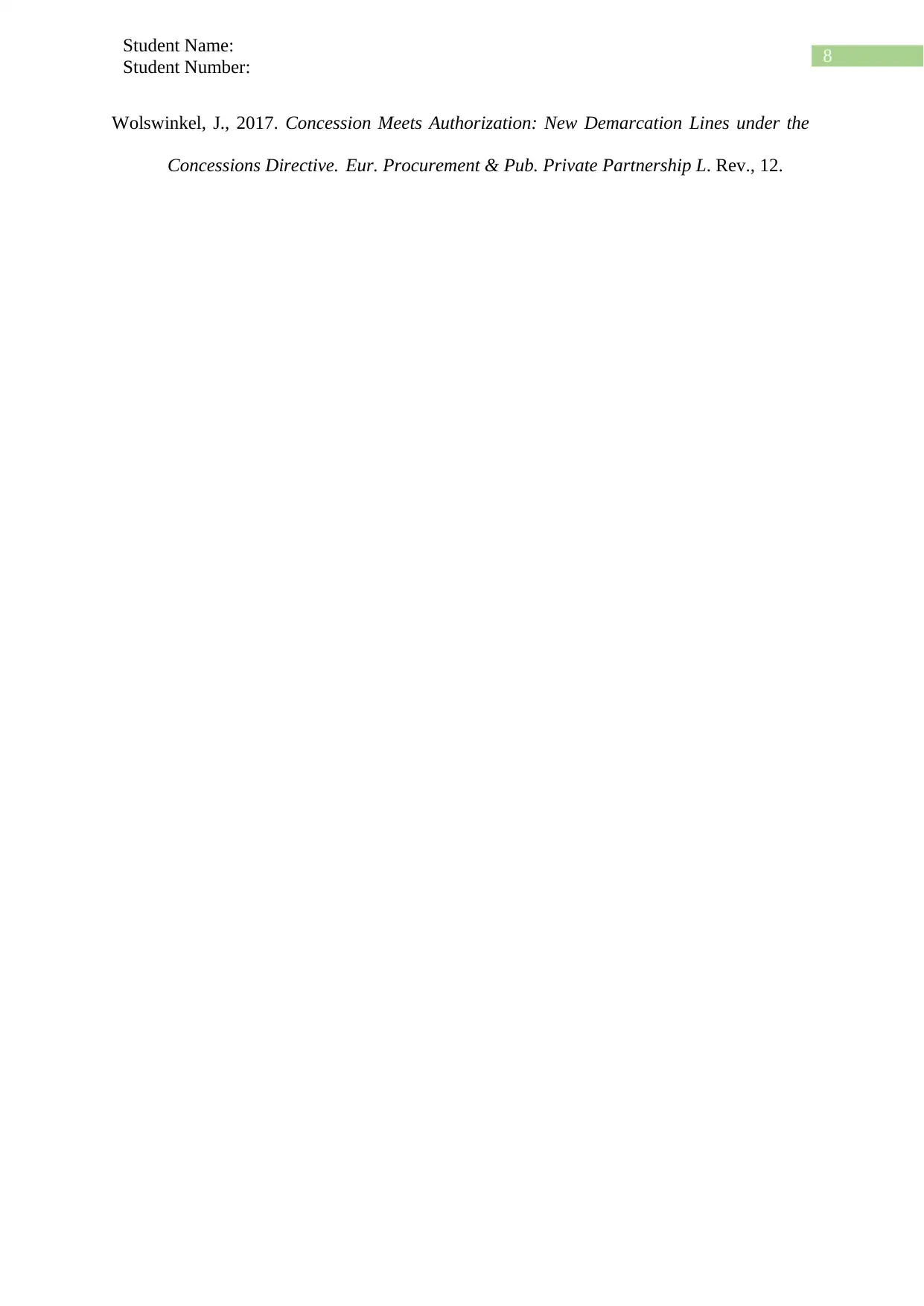
8
Student Name:
Student Number:
Wolswinkel, J., 2017. Concession Meets Authorization: New Demarcation Lines under the
Concessions Directive. Eur. Procurement & Pub. Private Partnership L. Rev., 12.
Student Name:
Student Number:
Wolswinkel, J., 2017. Concession Meets Authorization: New Demarcation Lines under the
Concessions Directive. Eur. Procurement & Pub. Private Partnership L. Rev., 12.
⊘ This is a preview!⊘
Do you want full access?
Subscribe today to unlock all pages.

Trusted by 1+ million students worldwide
1 out of 9
Related Documents
Your All-in-One AI-Powered Toolkit for Academic Success.
+13062052269
info@desklib.com
Available 24*7 on WhatsApp / Email
![[object Object]](/_next/static/media/star-bottom.7253800d.svg)
Unlock your academic potential
Copyright © 2020–2025 A2Z Services. All Rights Reserved. Developed and managed by ZUCOL.





